Toko 4x 10° (Richtkreis)Zu dem hier gezeigten Japanischen Richtkries der Firma TOKO gehört ein monokulare Zielvisier oder Peilfernrohr. Der Okulardeckel trägt die Aufschrift "4x" für die Vergrößerung und "10°" für den Sehwinkel, sowie den Firmennamen mit Logo und "No 1678" (weiteres: 10825) sowie " J.E.S" (= Japanese Enginering Standards). Dahinter sind zwei weitere Zeichen, die wohl für die Art der Schrauben bzw. Gewinde stehen (s. Rohan 2001, S. 164) zu erkennen. Die Länge des Monokulars ist ca. 80-85mm.Der Peilkreis und das Visier sind aus massiven Messing mit einer oliv-ockerbraunen Lackierung, typisch für die Japanischen Militäroptiken des 2. WK. Das Monokular ist mit zwei seitliche Trägerarmen auf dem Richtkreis befestigt. |
Toko 4x 10° (aiming circle)The Japanese aiming circle depcited here comes with a monocular sight made by Toko. The eyepiece housing cover is labeled "4x" denoting its magnification, and "10°" which gives the angle of view. This is followed by the producer's name and logo, "No 1678" (further model "10825") and J.E.S." (= Japanese Enginering Standards), also followed by to further signs that stand for the sort of screws or the threads used (cf. Rohan 2001, S. 164). The monocular is 80-85mm long.The aiming circle and the sight are made of solid brass with an olive-ochre-brown paint which is typical for Japanese military optics form WWII. The sight is attached onto the aiming circle with two mounting arms. |
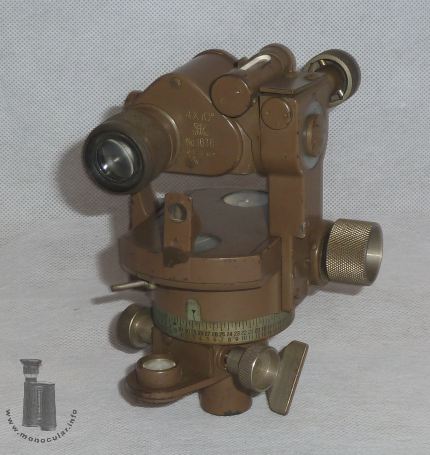
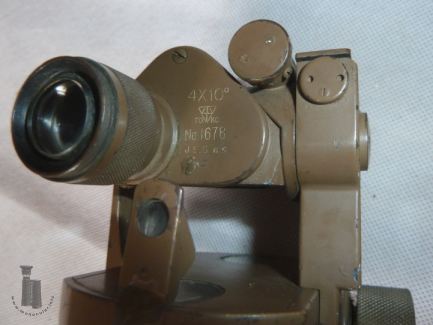
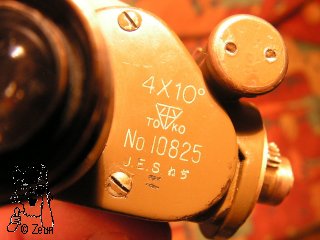
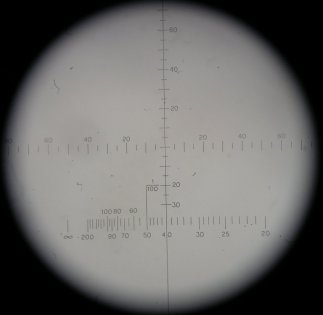
| Das 26mm Okular hatte ursprünglich eine Augenmuschel (Gewinde vorhanden!) und ist mit einem Dioptrienausgleich ausgestattet. Im Okular befindet sich eine Strichplatte mit verschiedenen Strichmarkierungen zum Anpeilen und Entfernungsmessen (s. Foto). Diese lässt sich durch ein kleines Fenster auch im Dunkeln beleuchten. Die 16mm Objektivlinse hat eine 25mm Objektivfassung. Das Gehäuse ist dreieckig mit abgerundeten Ecken. Die Maße der Seiten sind 40x40x48mm. Auf einer der kürzeren oberen Seiten ist eine Kunststofffläche, deren Funktion mir unbekannt ist. Bei anderen Richtkreisen war dies Fläche unten am Monokular und phosphorisierend, um den darunter liegenden Kompass etwas zu beleuchten. Seitlich rechts oben am Monokular ist eine kleine Wasserwaage zur Ausrichtung. Diese lässt sich mit einem Klappdeckel abdecken. In der Neigung justiert wird das Monokular mit einem zum Objektiv hin gerichtetem Stellrad am Trägerarm. Dort ist eine Skala von + bis - 5 zum Ablesen der Neigung. |
The 26mm ocular piece originally had an eyecup, because there is a thread for it. The eyepice has a dioptre adjustment with a +/-5 scale. The sight comes with a reticle that has sveral division markings for targeting and measuring distances (s. photo). The reticle can be lightened through a tiny window on top of the sight. The 16mm objective lense is held in a 25mm frame. The body is triangular with rounded edges. The sides measure 40x40x48mm. There is a plastic area on one of the top sides. Its function is not clear to me. Other aiming circle sights had such a bottom area which was phosphorescent to illuminated the compass. At the top right-hand side of the monocular is a small bubble lever to adjust the sight. The bubble lever's glass can be sheltered with a cover that swings over it. You can adjust the declination with a turning knob on the objective side. There is a +/-5 scale on the side of the mounting arm. |
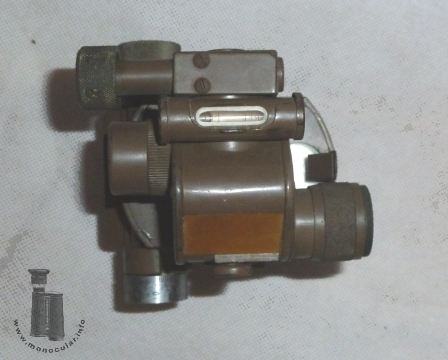

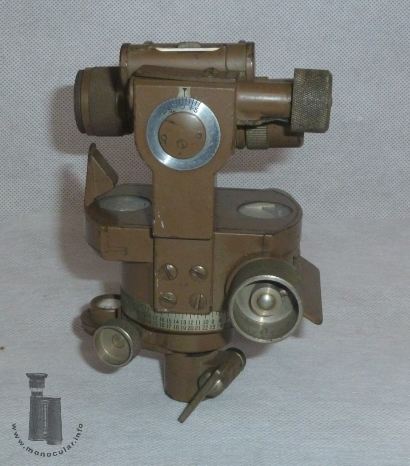
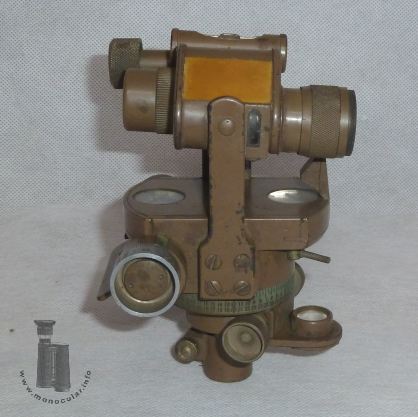
| Auf dem Peilkreis zwischen den Trägerarmen befindet sich ein Kompass in einem länglichen Gehäuse mit abgerundeter Vorder- und Rückseite. Die Kompassnadel darin dient zur Nordausrichtung, es gibt keine weitern Richtungsangaben. Dei Nadel kann durch zwei runde Fenster in dem Deckel abgelesen werden. Ein kleines Spiegel-Umlenkvisier an der Okularseite des Monokulars ermöglicht ebenfalls das Einsehen des einen Fensters. Bei erreichter Einnordung lässt sich mittels eines kleinen Hebels an der Gehäuseunterseite die Nadel feststellen. Ein Pfeil und ein japanisches Zeichen gekennzeichnet dies. Der Richtkreis selbst hat eine Skala von 0-32, gefolgt von nochmals 0-32 in beiden Richtungen. Wie bei vielen Richtkreisen üblich lässt sich die azimutale Abweichung mit einem Feintrieb oder bei Herunterklappen eines breiten Hebels an der Objektivseite eine Schnellverstellung justieren. Der Sockel hat einen Stativadapter mit Fixiermöglichkeiten. An ihm ist ein Dosen-Libelle zur waagerechten Aufstellung angeschraubt. |
On the aiming circle between the mounting arms there is a a compass on a rectangular housing with rounded front and back end. The compass needle is only used for North alignment, there is no further direction scale. The needel can be watched through two small round windows in the top cover. A small mirrored upright sight can be used to also see the needle in one of the windows. When oriented the needle can be locked by menas of a tiny lever ont he bottom sof the compass housing. This is also marked withan arrow and Japanese sign. The aiming circle itself has a scale ranging from 0-32 plus again 0-32 in both directions. As usual with aiming circles the aziomuthal deviation can be set with a fine adjustment or quick rotation when flipping down a broad lever on the objective end. The base comes with a tripod adapter with tightening knobs. A box level is screwed onto the base for correct level positioning. |
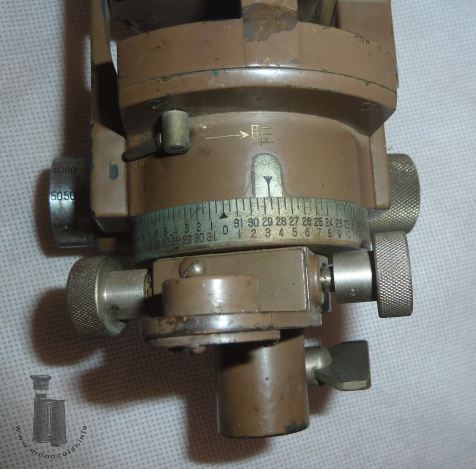
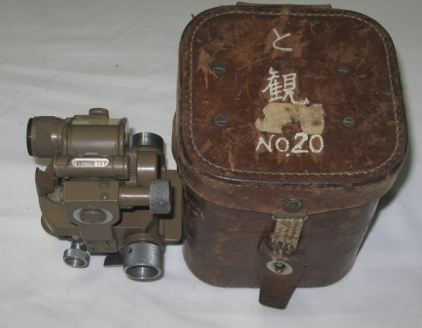
| Das Instrument wiegt 1452g. Es ist 14cm hoch und ca. 10x9cm breit. | The instrument weighs 1452g. It is 14cm tall, and about 10x9cm wide. |
Fotos: Zeun; 10 Internet

